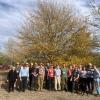Editor's Picks
Plant Focus
Poster presented at the XX International Botanical Conference, Madrid, Spain, July 21–27, 2024.
Authors:
Matthew A. Kaproth1,2, Jeannine Cavender-Bares1, Alex Kirsch2, Antonio González-Rodríguez3, Marlene Hahn4, Andrew L. Hipp4,5
Affiliations:
1. University of Minnesota, St. Paul, USA
2. Minnesota State University Mankato, Mankato, USA
3. Universidad Nacional Autónoma de México, Morelia, México
4. Center for Tree Science and Herbarium, The Morton Arboretum, Lisle, USA
5. The Field Museum, Chicago, USA
Abstract:
The sympatric nature of Quercus (oak) clades in the Americas offers insights into evolutionary dynamics and environmental adaptations across broad environmental conditions. While species occupy similar regions, it is unknown if species use similar strategies to adapt to different ecological niche. We explored these patterns using herbarium surveys of 136 species (1820 specimens), with species represented by leaf and stem traits (e.g., leaf perimeter to area ratio, specific leaf area, leaf habit, huber value) and their correlation with climate and soil nutrients.
Our study reveals convergent leaf morphology and habit patterns across clades, particularly in Mesoamerica. Both section Lobatae (reds) and Quercus (whites) show constrained adaptations to environmental conditions. The relationship between leaf density (SLA) and dissection (perimeter × leaf length per area; PLA) is coupled by region, demonstrating function is convergent across distantly related species that are occupying similar niches. For leaf habit, seasonal water and soil nutrient availability are identified as important interactive factors; deciduous species grow in seasonally dry climates and more nutrient-rich soils compared to brevideciduous or evergreen species, matching strategies that align along the leaf economic spectrum.
We investigate whether there is parallel evolution of water use and cold tolerance traits among clades. Previous work demonstrates high rates of speciation, habit evolution, and adaptation along moisture gradients in the Mexico and American Southwest regions. This research expands on findings that clades are responding to patterns of resource heterogeneity in similar manners, but with evergreen species displaying higher rates of transition.
This research enhances our understanding of the intricate relationships between evolutionary patterns, environmental adaptations, and convergent leaf functional traits in woody plant species. The findings underscore the importance of considering regional variations soil and climate for a comprehensive analysis of ecological strategies and species’ success.
















